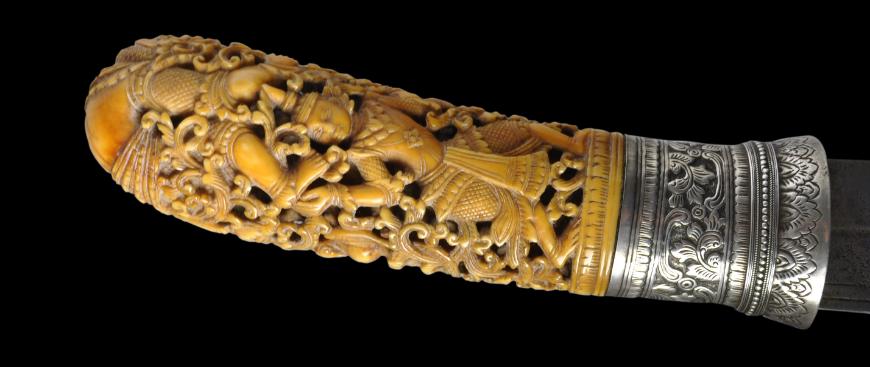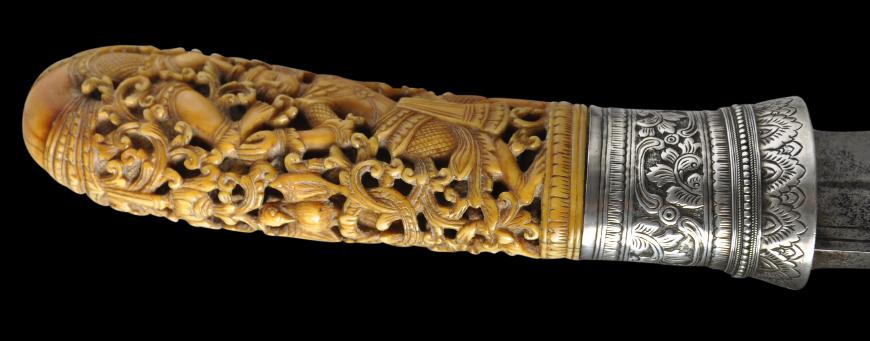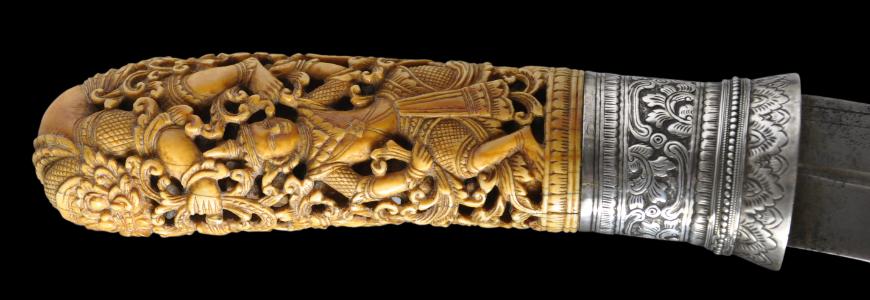
Exceptional Burmese Dha
Exceptional Short Dha with Carved Ivory Gilt & Engraved Silver Mounts Inscribed with the Name ‘Mom Chao (Prince) Udom Direklabh’
Burma
19th century
length: 43cm, weight: 631g
This superb museum-quality Burmese short dha or dha-hmyaung is among the finest of its type. It comprises a short, single-edged steel blade, a pierced ivory hill of the highest quality, and a wooden scabbard encased in red cotton fabric with engraved silver mounts.
If the silver mounts and fabric covering on the scabbard are carefully removed, the wooden shell of the scabbard is revealed and carved into the wood on one side in large Thai script are the words ‘Mom Chao Udom Direklabh’. ‘Mom Chao’ is the equivalent of ‘Prince’ and the rest is a personal name. Thus, the
dha at one point came into the possession or maybe was even commissioned for a Thai prince. The term Mom Chao was used to denote a grandson (and also a granddaughter) of the Thai king and a mother who was a commoner.
Mom Chao Udom Direklab is listed in the 1914 ‘Directory for Bangkok and Siam’, published by the Bangkok Times Press Ltd as serving as the Chief Revenue Officer for the Krungkao region, which essentially approximated to the old capital of Ayutthaya. His full name was Mom Chao Udom Direklabh Thaviwongse. He was born in 1877 and died by 1953. He was the eldest son of Phra Ong Chao (literally ‘Royal Body Prince’ but rendered in English as ‘His Royal Highness Prince’) Thavi Thavalyalabh, Prince Bhudhares Dhamrongsakdi (1856-1897).
In turn, Prince Thavi Thavalyalabh was the tenth son of His Majesty King Mongkut (Rama IV) of Siam (b. 1804 – d. 1868; r. 1851 – 1868) and a younger half-brother by a different mother of His Majesty King Chulalongkorn (Rama V) of Siam (b. 1853 – d. 1910; r. 1868 – 1910). Prince Thavi Thavalyalabh is the founder of the Thaviwongse na Ayudhya princely family, which is still present in Thailand today.
The
dha most probably was a gift from Prince Udom Direklabh’s father or possibly even King Rama V as a symbol of office or regalia.
Thai kings had many official wives and concubines and thus many sons – Mongkut himself had at least 82 children. Each need a job and so it seems that Udom Direklabh was appointed as the tax overseer of Ayutthaya (most probably he operated as a tax ‘farmer’, earning a living by keeping whatever was raised in excess of some target amount that had to be given to the central authorities.) It would have been appropriate to award the position overseeing tax collections in the old historic capital to a son of a king. It is ironic too that this Burmese weapon should bear his name given that the Burmese largely destroyed Ayutthaya in 1767.
The hilt is carved with a large
bilu or demon figure and several human figures in Burmese courtly dress all amid scrolling, pierced foliage. The silver mounts are in bands that have been delicately chased with Indian lotus motifs. The chasing is of the finest quality.
The ivory hilt is in pristine condition without any losses and with a wonderful, glossy, cream patina. There are no losses to the silverwork on the scabbard – just some expected deterioration to the red fabric that covers the wooden sub-structure. There is some pitting to the blade but it is clean and free of rust stains. Overall, this is among the highest level of Burmese weapons available.
References
Edward Thiravej Ploysongsang, pers. coms., December 2015.
Fraser-Lu, S.,
Burmese Crafts: Past and Present, Oxford University Press, 1994.
Hales, R.,
Islamic and Oriental Arms and Armour: A Lifetime’s Passion, Robert Hale CI Ltd, 2013.Provenance:
private collection
Inventory no.: 3200
SOLD
here












